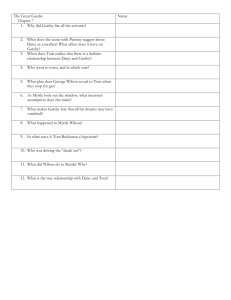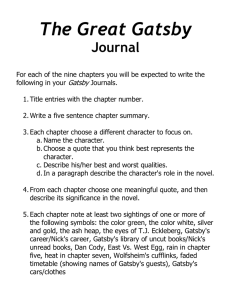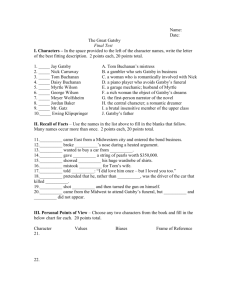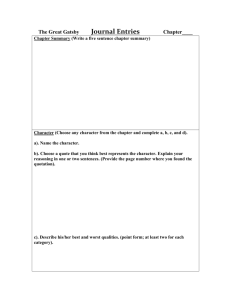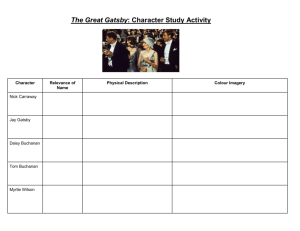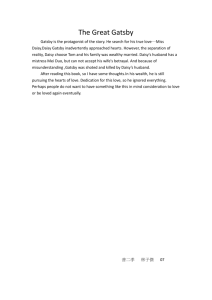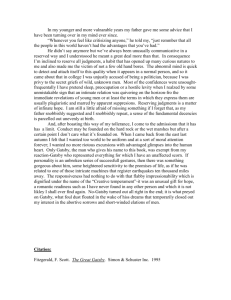11600,"jay gatsby physical description",7,8,"2000-11-15 00:00:00",70,http://www.123helpme.com/view.asp?id=72633,3.9,90700,"2015-12-20 07:22:27"
advertisement
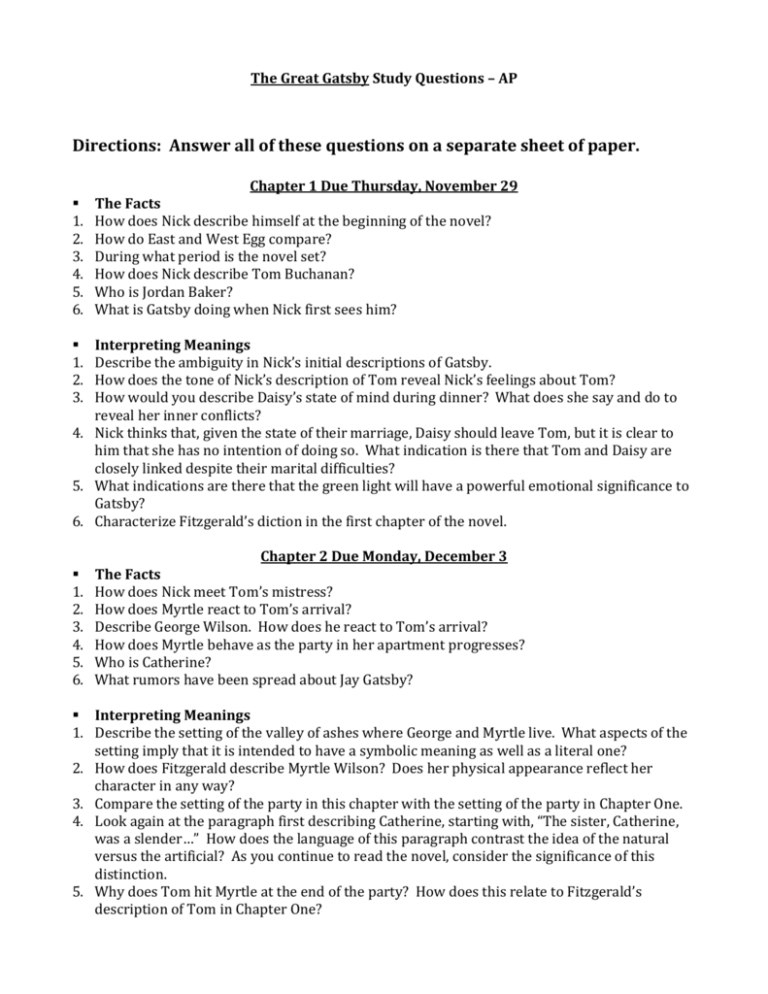
The Great Gatsby Study Questions – AP Directions: Answer all of these questions on a separate sheet of paper. 1. 2. 3. 4. 5. 6. Chapter 1 Due Thursday, November 29 The Facts How does Nick describe himself at the beginning of the novel? How do East and West Egg compare? During what period is the novel set? How does Nick describe Tom Buchanan? Who is Jordan Baker? What is Gatsby doing when Nick first sees him? Interpreting Meanings Describe the ambiguity in Nick’s initial descriptions of Gatsby. How does the tone of Nick’s description of Tom reveal Nick’s feelings about Tom? How would you describe Daisy’s state of mind during dinner? What does she say and do to reveal her inner conflicts? 4. Nick thinks that, given the state of their marriage, Daisy should leave Tom, but it is clear to him that she has no intention of doing so. What indication is there that Tom and Daisy are closely linked despite their marital difficulties? 5. What indications are there that the green light will have a powerful emotional significance to Gatsby? 6. Characterize Fitzgerald’s diction in the first chapter of the novel. 1. 2. 3. Chapter 2 Due Monday, December 3 1. 2. 3. 4. 5. 6. The Facts How does Nick meet Tom’s mistress? How does Myrtle react to Tom’s arrival? Describe George Wilson. How does he react to Tom’s arrival? How does Myrtle behave as the party in her apartment progresses? Who is Catherine? What rumors have been spread about Jay Gatsby? Interpreting Meanings 1. Describe the setting of the valley of ashes where George and Myrtle live. What aspects of the setting imply that it is intended to have a symbolic meaning as well as a literal one? 2. How does Fitzgerald describe Myrtle Wilson? Does her physical appearance reflect her character in any way? 3. Compare the setting of the party in this chapter with the setting of the party in Chapter One. 4. Look again at the paragraph first describing Catherine, starting with, “The sister, Catherine, was a slender…” How does the language of this paragraph contrast the idea of the natural versus the artificial? As you continue to read the novel, consider the significance of this distinction. 5. Why does Tom hit Myrtle at the end of the party? How does this relate to Fitzgerald’s description of Tom in Chapter One? Chapter 3 Due Monday, December 3 1. 2. 3. 4. 5. 6. The Facts Describe the two ways in which Nick differs from the other guests at Gatsby’s party. What does Nick think of Gatsby when he first meets him? Describe the events and atmosphere of the party. What new rumors does the reader learn about Gatsby in this chapter? What does the owl-eyed man in the library find extraordinary about Gatsby’s library? What does Nick learn about Jordan Baker after he has spent some time with her? Interpreting Meanings 1. Why does Fitzgerald describe the party (in the passage beginning “By seven o’clock the orchestra has arrived”) in the present tense? 2. How does Nick characterize the guests at Gatsby’s party? What do his characterizations tell us about how Nick feels about most of these people? What sense of life in the Jazz Age do we get from the description of this party? 3. Describe the ambiguity in Gatsby’s character that strikes Nick. 4. Describe two incidents involving automobiles in this chapter. What role do automobiles seem to play in the novel so far? Chapter 4 Due Wednesday, December 5 The Facts 1. What does Gatsby tell Nick about himself? 2. What accomplishments of Meyer Wolfsheim’s does Gatsby describe to Nick? How does Nick react? 3. According to Jordan, what did Daisy do on her wedding way? Why? 4. Why does Gatsby want to have tea with Daisy in Nick’s house? Why doesn’t Gatsby ask Nick for this favor himself? 5. What does Tom do when he and Daisy return from their honeymoon? Interpreting Meanings 1. Aside from the improbability of his story, what other evidence is there that Gatsby is lying when he tells Nick about his background? 2. What does Gatsby’s friendship with Meyer Wolfsheim imply about his own background? 3. How does Daisy behave after Gatsby goes overseas? What does her behavior show about her feelings for Gatsby? 4. After Jordan tells Nick the story of Gatsby and Daisy, Nick says that Gatsby “came alive to me, delivered suddenly from the womb of his purposeless splendor.” How does the metaphor of birth help explain what Gatsby’s behavior had meant to Nick up to then? 5. With Jordan in his arms, Nick thinks of a phrase: “There are only the pursued, the pursuing, the busy, and the tired.” How do you think this phrase reflects on the events of the novel so far? Do you think that Gatsby would agree with the phrase? Why or why not? 1. 2. 3. 4. 5. Chapter 5 Due Wednesday, December 5 The Facts What does Gatsby offer Nick in return for Nick’s cooperation in inviting Daisy to his house? What is the meeting between Gatsby and Daisy like initially? How are Daisy and Gatsby different when Nick returns to the house after a half an hour? What are Gatsby’s feelings by the end of the chapter? What does Gatsby reply when Nick asks him how he makes his money? Why does Nick find that significant? 6. Who is Klipspringer? Interpreting Meanings What is Gatsby’s dialogue like in this chapter? What does it tell us about Gatsby? Why do you think Daisy sobs when Gatsby shows her his shirts? What is the weather like in this chapter? How does it reflect on the emotional climate of Gatsby and Daisy? 4. We learn the symbolic significance of the green light at the end of the dock on page 98. What does it represent to Gatsby? 5. In this chapter, Gatsby’s dream seems to be fulfilled. What indications are there, though, that reality cannot satisfy his dream? 1. 2. 3. Chapter 6 Due Friday, December 7 1. 2. 3. 4. The Facts When does James Gatz change his name? Why? What is Dan Cody’s role in Gatsby’s transformation? What is Daisy’s real response to the party, according to Nick? What does Gatsby tell Nick he wants Daisy to do? Interpreting Meanings 1. Plato held that reality was an imperfect reflection of an ideal, permanent realm. With this in mind, what would you say Nick means when he says that “Jay Gatsby sprang from his Platonic conception of himself?” 2. How is the comparison of Gatsby with Christ (“he was a son of God… and he must be about his Father’s business”) ironic? If the comparison with Christ were to continue through the book, what would happen to Gatsby? 3. There is a time shift on page 107. How/why does Nick manipulate time in his narrative? 4. Tom, Mr. Sloane, and a young lady visit Gatsby and the lady invites Gatsby to come to dinner with them. What does Gatsby’s response tell us about his social sensitivity? What connection, if any, do you think this scene might have with Gatsby’s love of Daisy? 5. What is Gatsby’s view of the past? When Nick says that Gatsby “wanted to recover something, some idea of himself perhaps, that had gone into loving Daisy,” what do you think he means? 6. At the end of the chapter, Nick describes Gatsby kissing Daisy in Louisville five years before. What is Gatsby giving up when he kisses her? Why? 7. What effect does the time shift on page 116 have on the reader’s concept of Gatsby? What is the tone of this passage? 1. 2. 3. 4. 5. Chapter 7 Due Friday, December 7 The Facts Why does Gatsby stop giving parties? When does Tom first realize that Daisy loves Gatsby? Why is Myrtle Wilson upset when she sees Tom and Jordan? Why does George Wilson lock Myrtle in the bedroom? Who is Walter Chase? How does Tom use his name to discredit Gatsby in front of Daisy? Interpreting Meanings 1. What effect does Pammy have on Gatsby? Why? 2. How does Gatsby characterize Daisy’s voice? What do you think he means by this? 3. Why does Gatsby lose Daisy during the confrontation at the Plaza? Could he have done anything to win her, do you think? If he could have, why doesn’t he? 4. Why does Tom insist that Daisy go home with Gatsby? What do you think this tells us about Tom’s character and his relationship with Daisy? 5. Several people provide details about Myrtle’s death. What happened? 6. What indications are there are the end of the chapter that Tom and Daisy are going to stay together despite his philandering and her love for Gatsby? 7. At the end of the chapter, Gatsby is standing alone, looking out at Daisy’s house. Where else in the novel does he do this? How is this different? 1. 2. 3. 4. Chapter 8 Due Monday, December 10 The Facts What does Gatsby tell Nick the night of the accident? Why? Did Gatsby want to go to Oxford? How does George Wilson spend the night after the accident? What evidence had Wilson found that his wife was having an affair? Interpreting Meanings 1. What would you say is the principal reason for Daisy’s appeal to Gatsby? 2. How is Nick’s attitude toward Gatsby ambivalent even at the moment when he says goodbye to him? 3. What do the eyes of Dr. T. J. Eckleburg symbolize to George Wilson? What is significant about this symbol? 4. How do you think Wilson got Gatsby’s name? Does any evidence in this chapter point to a particular person? 5. At what moment did you know what had happened to Gatsby? Why/how? 6. How does Nick characterize Gatsby’s state of mind before he is killed? 7. Why does Fitzgerald call the situation between Wilson and Gatsby a “holocaust”? Chapter 9 Due Monday, December 10 1. 2. 3. 4. 5. 6. The Facts What is the motive publicly given for Wilson’s murder of Gatsby? What does the telephone call from Chicago tell us about Gatsby’s business? What does Klipspringer want from Nick? How does Nick react to this? Why is Gatsby’s father so proud of him? Describe the end of Nick’s relationship with Jordan. What does Tom confess to Nick when they meet that fall? Does he regret what he has done? Interpreting Meanings 1. Chapter 9 begins in the present. How much time has passed since all of the events in the narrative took place? 2. Nick says that “this has been a story of the West, after all.” What do you think he means by that? 3. How does Nick characterize Tom and Daisy at the end of the book? What has each of them “smashed” during the course of the novel? 4. At the end of the book, Nick imagines what the continent must have been like when it was first seen by Dutch sailors. How does this contrast with the environment described in the novel? 5. What does the green light symbolize at the end of the novel? The Novel as a Whole 1. Discuss Nick Carraway’s character. How reliable is he as a narrator? What aspects of his character make him an effective narrator? 2. Why is first-person narrative an effective and appropriate way of telling this story? 3. Discuss the title of the book. In what way is Gatsby “great?” 4. An epigraph is a quotation at the beginning of a work that reflects on that work. How does the epigraph to The Great Gatsby reflect on Gatsby’s story? 5. How does Fitzgerald use Gatsby’s parties to present a satirical portrait of the Roaring Twenties? 6. Compare and contrast the character of Daisy and Myrtle Wilson. 7. Discuss the relationship between Nick and Jordan Baker. How does it reflect, if at all, on the story of Gatsby and Daisy? 8. Discuss Fitzgerald’s use of the automobile in this novel. What do you think might have made the automobile an appealing symbol to Fitzgerald in the early 1920s? 9. Contrast the setting of the valley of ashes with that of East Egg and West Egg. 10. Describe the gradual revelation of Gatsby’s character. What do we learn about him and when? Why is this an appropriate way of learning about him? 11. Gatsby’s tragedy is that he chooses the wrong dream (Daisy). Has he been corrupted by society? Or is his choice an indication that he is part of the corruption?

